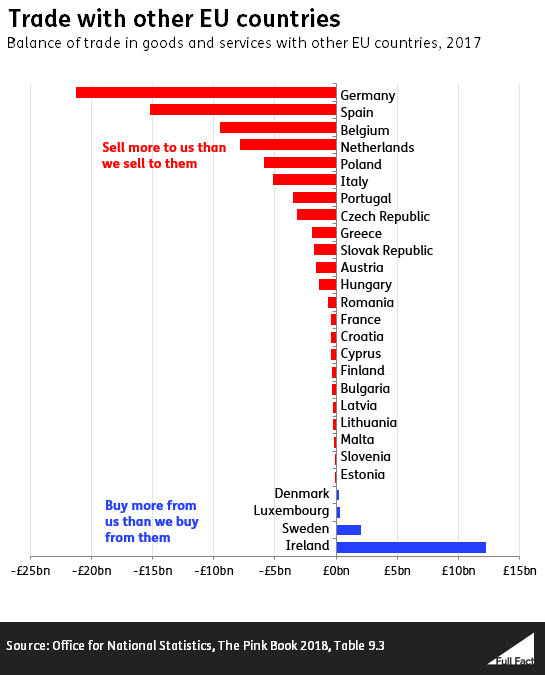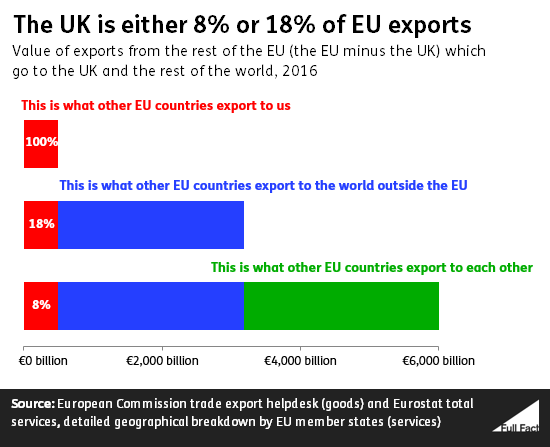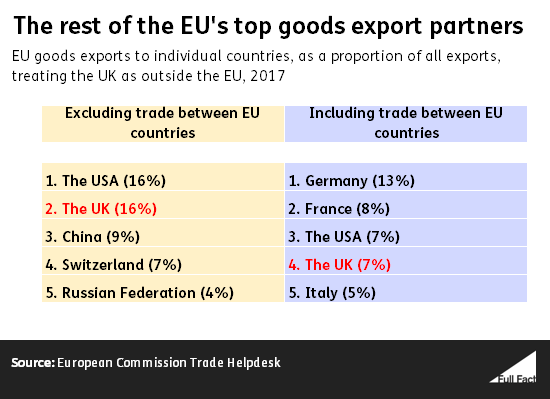Everything you might want to know about the UK's trade with the EU
Join 72,547 people who trust us to check the facts
Subscribe to get weekly updates on politics, immigration, health and more.
Trade with the EU matters a lot, but slightly less than it used to
About 44% of UK exports in goods and services went to other countries in the EU in 2017—£274 billion out of £616 billion total exports.
That share has generally been declining, since exports to other countries have increased at a faster rate.

The EU’s share of the world economy has been declining too. In particular, the developing world has been growing faster than the developed world and is expected to continue doing so.
53% of our imports into the UK came from other countries in the EU in 2017.
It’s sometimes argued that these statistics overstate the proportion of UK exports that go to the EU, because a lot of goods pass through ports like Rotterdam before being shipped to a final destination outside the EU.
Both the Office for National Statistics and the government's review of our EU membership have concluded that it's hard to quantify the extent of this ‘Rotterdam effect’ or establish whether it's a serious problem for the statistics.
The ONS has estimated that it may account for around 2% of all exported goods and services to the EU.
Trade after we leave
After the UK leaves the EU, the future rules on trade will depend on what kind of agreement, if any, the UK reaches with the EU after its departure. Trade in services will be particularly important, because about 80% of the UK economy comes from providing services.
The future trade rules on services for a country outside the EU are particularly difficult to predict. We’ve got more on this here.
After the UK leaves the EU we will still continue to trade with EU countries. The government wants to negotiate a new trade agreement to make that trade easier.
If no new trade deal is negotiated and trade took place under World Trade Organisation rules, we would have to pay tariffs on some goods.
How much is UK-EU trade worth to each party?
There are lots of ways to look at how much trade between the UK and EU is worth to each party.
Here are three of the most common: the value of the UK’s exports to the rest of the EU and the rest of the EU’s exports to us, how those measure up as a proportion of the UK and EU’s total exports and as a proportion of their economies.
Now for the detail…
Other EU countries sell more to us than we sell to them
It’s often claimed that other EU countries sell more to us than we sell to them. Taking other EU countries as a bloc, that’s correct.
In 2017, the rest of the EU sold about £67 billion more to us in goods and services than we sold to them, according to UK data—so the UK runs a “trade deficit” with the rest of the EU.
Exports of goods and services to other EU countries were worth £274 billion in 2017, while exports from the rest of the EU to the UK were worth about £341 billion.
Those figures will differ if you look at EU data, and the Office for National Statistics told us that this is because EU countries collect data about services in different ways.
EU data for both goods and services is only available until 2016, and this shows different figures than data from the UK for the same year.
EU figures suggest goods and services exported from the rest of the EU to the UK could have valued up to £394 billion in 2016 (using the 2016 average exchange rate)—higher than the £315 billion in the UK data. Either way, the rest of the EU as a whole sells more to us than we sell to it, and that’s the case for the majority of EU countries.

Within that overall picture, there’s a lot of variation in the trade that each individual country does with us. We have our biggest trade deficit with Germany— in 2017 it sold about £21 billion more to us than we sold to it, according to the latest UK data.
8% of EU exports go to the UK is one possible estimate
You might have heard the claim that only 8% of the EU’s exports go to the UK, compared to the well over 40% of UK exports that go to other EU countries.
Whether the 8% is correct depends on how you treat exports between EU countries. Looked at another way, you can get 18%.
About 8% of the EU’s goods and services exports to EU and non-EU countries went to the UK in 2016. That includes exports from EU countries to other EU countries, as well as to non-EU countries.
The other way to look at it is to say that what we’re really interested in is how important the UK would be to the EU’s trade with countries outside of the EU only, when we leave the EU. Looked at that way, about 18% of the EU’s goods and services exports to non-EU countries went to the UK in 2016, according to EU data.

The UK is the EU’s second largest single export market for goods
It’s been claimed in the past that the UK is the EU’s largest single export market for goods.
This used to be the case if you treated the UK as if it were not in the EU and focus on EU goods exports to non-EU countries. In 2016 it changed so that the USA was very slightly ahead. Using the latest figures for 2017 slightly more EU goods exports went to the USA than to the UK, and about 16% of total EU goods exports went to each.
If you’re counting EU countries too then Germany receives the largest amount of goods exports from other EU countries.

It’s more complicated to work this out for services due to the variation between each country’s data.
UK-EU exports are a bigger part of the UK’s economy than the EU’s
Although fewer of our exports are now going to other EU countries, these exports are still just as important to our economy.
The £274 billion exports of goods and services to other EU countries were worth 13.4% of the value of the British economy in 2017. It’s been at around 12-15% over the past decade.
Exports from the rest of the EU to the UK were worth about 3-4% of the size of the remaining EU’s economy in 2016. The exact number depends on whether you use the £394 billion figure from EU goods and services data, or £315 billion from UK data.
Correction 23 March 2017
We originally said in the first section of this article that:
“The European Commission itself says that “over the next ten to 15 years, 90% of world demand will be generated outside Europe”.”
While this was quoted from the Commission’s website, it has since been removed.
The Commission told us that this should have read: “90% of global economic growth by 2015 is expected to be generated outside Europe”, from a working document. This was based on IMF forecasts in 2012 for GDP growth worldwide up to 2015.
We’ve replaced this with the paragraph about the EU’s declining share of the world economy.